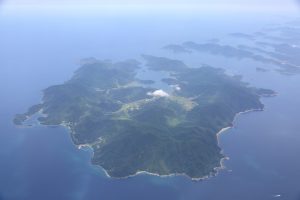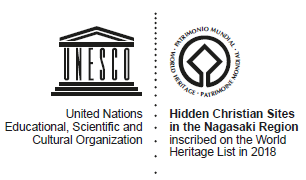 |
‘Hidden Christian Sites in the Nagasaki Region’ are widely distributed across several remote islands and peninsulas in the Nagasaki region. Japan lies at the far eastern edge of the area within Asia in which Christianity was introduced during the Age of Exploration, and the Nagasaki region experienced the most extensive Catholic mission in the country at that time. |
-

The site of the main battlefield during the Shimabara-Amakusa Rebellion, after which the remaining Christians had to go into hiding and find ways out to continue their religious faith by themselves.
-

 Kasuga Village and Sacred Places in Hirado (Kasuga Village and Mt. Yasumandake)
Kasuga Village and Sacred Places in Hirado (Kasuga Village and Mt. Yasumandake)Hidden Christians concealed their faith in this village by venerating the mountain that had been worshiped since before the introduction of Christianity to Japan and the island on which their ancestors had been martyred.
-

 Kasuga Village and Sacred Places in Hirado (Nakaenoshima Island)
Kasuga Village and Sacred Places in Hirado (Nakaenoshima Island)Hidden Christians concealed their faith in this village by venerating the mountain that had been worshiped since before the introduction of Christianity to Japan and the island on which their ancestors had been martyred.
-

In Sakitsu, Hidden Christians were able to continue practising their faith over time by substituting everyday items used in daily life and work for Christian devotional objects.
-

At this village, Hidden Christians were able to practise their faith by secretly revering sacred icons.
-

In Ono Village, Hidden Christians practised their religious faith by venerating their own deities secretly enshrined in Shinto shrines.
-

Hidden Christians maintained their religious communities after they settled in former clan pasturelands on Kuroshima Island in need of redevelopment.
-

 Remains of Villages on Nozaki Island
Remains of Villages on Nozaki IslandHidden Christians maintained their religious communities after they migrated to Nozaki Island, which was regarded as sacred by Shinto believers.
-

 Villages on Kashiragashima Island
Villages on Kashiragashima IslandHidden Christians maintained their religious communities after they migrated to Kashiragashima Island, which once had been used for sick people.
-

Hidden Christians maintained their religious communities in these villages after migrating to undeveloped land on the island in accordance with a migration policy established by feudal lords.
-

 Egami Village on Naru Island(Egami Church and its Surroundings)
Egami Village on Naru Island(Egami Church and its Surroundings)Egami Church bears witness to the history of Hidden Christian migrants to Naru Island and visually marks the end of their hiding.
-

The site of the ‘Discovery of Hidden Christians’, an encounter with returned Catholic missionaries that triggered the end of Hidden Christians’ hiding.

















 Remains of Hara Castle
Remains of Hara Castle Kasuga Village and Sacred Places in Hirado
Kasuga Village and Sacred Places in Hirado Kasuga Village and Sacred Places in Hirado
Kasuga Village and Sacred Places in Hirado Sakitsu Village in Amakusa
Sakitsu Village in Amakusa Shitsu Village in Sotome
Shitsu Village in Sotome Ono Village in Sotome
Ono Village in Sotome Villages on Kuroshima Island
Villages on Kuroshima Island Remains of Villages on Nozaki Island
Remains of Villages on Nozaki Island Villages on Kashiragashima Island
Villages on Kashiragashima Island Villages on Hisaka Island
Villages on Hisaka Island Egami Village on Naru Island
Egami Village on Naru Island Oura Cathedral
Oura Cathedral






